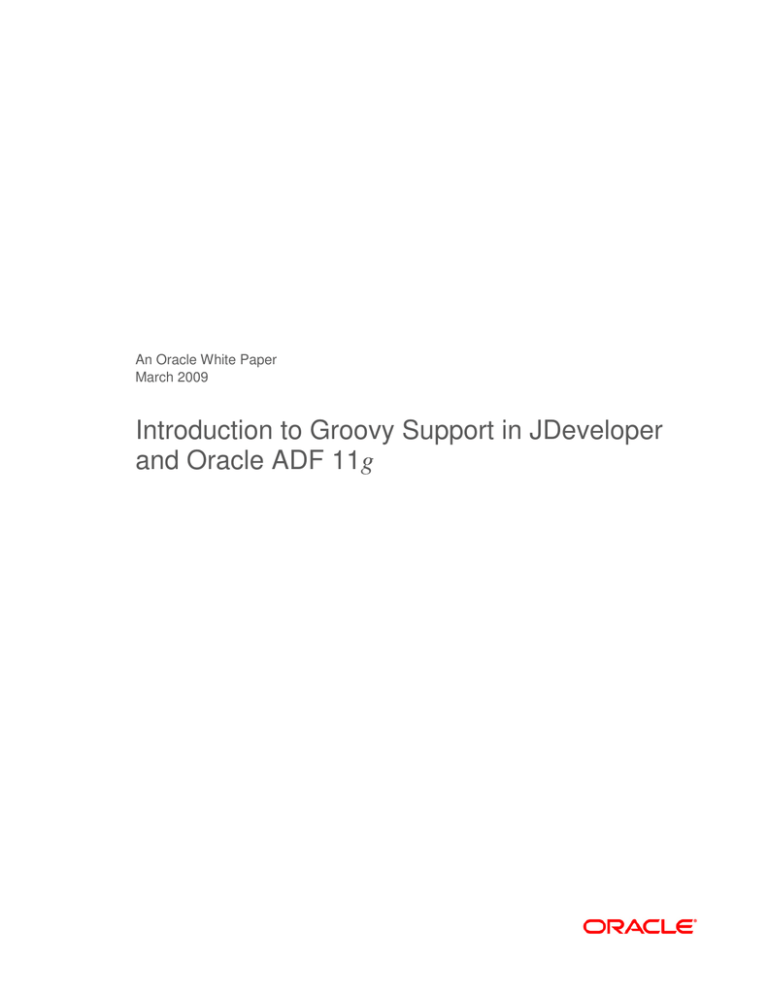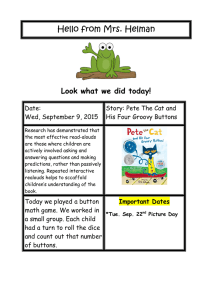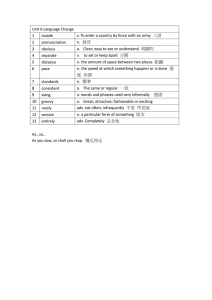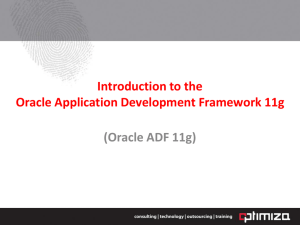
An Oracle White Paper
March 2009
Introduction to Groovy Support in JDeveloper
and Oracle ADF 11g
Oracle White Paper— Introduction to Groovy support in JDeveloper and Oracle ADF 11g
Oracle White Paper—Introduction to Groovy support in JDeveloper and Oracle ADF 11g
Introduction ....................................................................................... 2
Introduction to Groovy ....................................................................... 2
Groovy in JDeveloper and Oracle ADF.............................................. 2
Groovy expressions in ADF Business Components Entity Objects .... 3
Referencing attributes in the same entity....................................... 3
Referencing custom methods in the EntityImpl class ..................... 3
Referencing base class methods in the EntityImpl class................ 4
Using Groovy expressions in error messages................................ 6
Referencing attribtues in other entities........................................... 7
Referencing built-in calls................................................................ 9
Entity object Groovy diagram....................................................... 13
Groovy Expressions in ADF Business Components View Objects... 13
Conclusion ...................................................................................... 14
Oracle White Paper—Introduction to Groovy support in JDeveloper and Oracle ADF 11g
Introduction
Oracle JDeveloper and Oracle ADF 11g introduce support for the Groovy scripting
language, allowing Groovy expressions to be used in attribute validation and as a source
for attribute values. This paper gives and overview and examples of the support.
Introduction to Groovy
Groovy is as an agile dynamic language for the Java platform with many features that are inspired
by languages like Python, Ruby and Smalltalk, making them available to Java developers using a
Java-like syntax. Being a dynamic language, many features of the language are executed at
runtime as opposed to the compile-time, strongly typed language of Java.
The main points to take from this are that: where Java can be very “exacting” in how you
develop, Groovy is a little more forgiving and hence “agile”. Groovy runs inside the JVM, and
so can make use of the Java environment libraries; and give a Java-like language (strictly speaking,
it is a superset of Java) that provides a convenient and agile development experience.
For a starter’s guide on Groovy you can visit
http://groovy.codehaus.org/Getting+Started+Guide
Groovy in JDeveloper and Oracle ADF.
Where Groovy comes into its own is within Oracle ADF Business Components is helping to
bridge the gap between Oracle ADF’s declarative business logic, and where you have to get into
full blown Java coding. Furthermore, because Groovy is interpreted at runtime, it can be treated
as metadata and customized. So, you could have an application that has customized business
rules in Groovy and those customizations stored in Oracle ADF’s meta data services (MDS).
This means, for example, if you built your application for reselling then your application could be
using different business rules depending on the customer instance of the application.
Oracle ADF provides a number of different declarative points into which you can drop Groovy
code:
•
Values for view and entity objects attributes
•
Validation rules on entity object attributes
•
Expressions for error messages
2
Oracle White Paper—Introduction to Groovy support in JDeveloper and Oracle ADF 11g
•
Values for view object bind variables
•
View object transient attribute validation
Groovy expressions in ADF Business Components Entity
Objects
Groovy expressions can be placed in a number of different places in ADF Business
Components. For the main part, you will probably be applying them in entity and view object
attribute values and for entity object validations.
Referencing attributes in the same entity
The simplest example is to reference attributes in the same entity. So, for the transient attribute
AnnualSalary you could define a Groovy expression for the default to be:
Sal * 12
You can also use a Groovy expression for a validator. So, on the Sal attribute you might want to
define that a salesman must have a salary of less than 1000:
if (Job == "SALESMAN")
{return newValue < 1000}
else
return true
When you reference an attribute in a validator, the attribute-level validator fires before the new
value being validated is actually assigned to the attribute (which makes sense, since you want to
validate it before the attribute is set). So, this means if you want to refer to the new value you
use the expression newValue. In the Groovy support in ADF Business Components, newValue
returns the value the user has just input. You can also use oldValue to return the value before it
was changed.
Referencing custom methods in the EntityImpl class
If you have defined a method in your EntityImpl class, then this can be called as part of your
expression for an attribute default:
adf.object.getDefaultSalaryForGrade()
Unlike when referencing an attribute of the entity object, which can be done by simply
referencing the attribute name, when referencing a method, you are required to prefix the
method name with adf.object.
3
Oracle White Paper—Introduction to Groovy support in JDeveloper and Oracle ADF 11g
If you want to reference the same method from a validator, you have to use the source prefix.
source.getDefaultSalaryForGrade()
For example, you might use the following expression for a more dynamic check of the salary for
a salesman.
if (Job == "SALESMAN")
{
return newValue < source.getMaxSalaryForGrade(Job)
}
else
return true
Referencing base class methods in the EntityImpl class
In the previous example you were referencing your own custom methods in the EntityImpl class.
You can also reference base class methods as you would if you were coding directly in the
EntityImpl. For example, in the create method you may want to set the employeeId to a sequence
number retrieved from the database.
Figure 1. Setting employeeId from a database sequence
4
Oracle White Paper—Introduction to Groovy support in JDeveloper and Oracle ADF 11g
This is done in the EntityImpl by creating a sequence object and then calling getDBTransaction. –
as shown in figure 1
The same calls can be made using a Groovy expression as the value for the EmployeeId attribute:
(new oracle.jbo.server.SequenceImpl("EMPLOYEES_SEQ",
adf.object.getDBTransaction())).
getSequenceNumber()
Note that you are required to use the full name for the class (object.jbo.server.SequenceImpl) and object
is used as a reference to the EntityImpl.
Of course, in practice you might create an EntityImpl helper method:
protected oracle.jbo.domain.Number nextVal(String
sequenceName) {
SequenceImpl s = new
SequenceImpl(sequenceName,getDBTransaction());
return s.getSequenceNumber();
}
Then, the groovy expression can just be:
adf.object.nextVal("YOUR_SEQUENCE_NAME")
So, any methods that you call in the EntityImpl can also be called using Groovy. So, consider
the (slightly contrived) example of wanting to set the value of an attribute to the label of another
attribute. Using the following code you are calling the EntityImpl method and getting the label,
using the correct locale so you can pick up translated labels, and assigning to the lastName field.
adf.object.setEmail(adf.object.getAttributeHints("LastName").g
etLabel(adf.object.getDBTransaction().getSession().getLocaleCo
ntext()))
However, there is also another way of accessing the same information:
adf.object.hints.LastName.label
The keyword adf.object evaluates to the EntityImpl instance. The keyword hints refers to a Java
bean property getter for a property named hints. So, adf.object.hints accesses the hints bean
property and returns a java.util.Map. Like Groovy does with any Map object, it uses the next
"element" in the dotted syntax to lookup the map key of that name.
So adf.object.hints.LastName looks up the entry in the hints Map named "LastName", which is
another Map of all the UI hints available for this particular attribute. So, again as Groovy does
with any Map, it uses the next element in the dotted syntax to lookup the map key of that name.
5
Oracle White Paper—Introduction to Groovy support in JDeveloper and Oracle ADF 11g
So adf.object.hints.LastName.label looks up the entry in the adf.object.hints.LastName Map with the key
of "label".
You can compare how much simpler:
adf.object.hints.LastName.label
is to its Java equivalent:
getAttributeHints("LastName").getLabel(getDBTransaction().getS
ession().getLocaleContext());
Using Groovy expressions in error messages
As part of the validation for an entity object, you can define placeholders in the error messages
that are evaluated through Groovy expressions. So, for example, if you want to reference the
label and tooltip of a field as part of a validation error message you could create an error message
with placeholders as: “This is not a valid value for {x}. For this field you need to {y}.” The
values of x and y could come from Groovy expression (as noted before) such as:
source.getAttributeHints("HireDate").getLabel(source.getDBTran
saction().getSession().getLocaleContext())
source.getAttributeHints("HireDate").getTooltip(source.getDBTr
ansaction().getSession().getLocaleContext())
or using the briefer notation of:
source.hints.HireDate.label
source.hints.HireDate.tooltip
Thus, for an error on Hiredate you can refer to the label for the field and the tooltip text as part of
the error message.
6
Oracle White Paper—Introduction to Groovy support in JDeveloper and Oracle ADF 11g
Figure 2. Customizing an error message by calling an entity attribute control hint
Referencing attribtues in other entities
You can also reference attributes in other entities. For example, a new employee’s default salary
has a weighting depending on their location. So, the call to getDefaultSalaryForGrade
will pass the department location as a string.
This is achieved by referencing the accessor in the entity association. This allows the Groovy
expression for the employee entity object to “walk back” to the master department entity. For
example:
adf.object.getDefaultSalaryForGrade(Dept.Loc)
So, assuming a master/detail relationship between departments and employees with this
expression as the default for the Employees.Sal, it will call the Employees EntityImpl method and
pass in the value of Loc from the master.
Note, you are not referencing the name of the entity (Dept), it just happens to be that, by default,
when reverse engineering from the database, the name of the association that links Dept, and
Emp is called FkDeptnoAssoc and the accessors are called Dept and Emp. This is shown in figure
3.
7
Oracle White Paper—Introduction to Groovy support in JDeveloper and Oracle ADF 11g
Figure 3. Entity association
However, if you were to change the name of the source accessor to DeptContainingEmps as shown
in figure 4, then the Groovy call would be:
adf.object.getDefaultSalaryForGrade(DeptContainingEmps.Loc)
8
Oracle White Paper—Introduction to Groovy support in JDeveloper and Oracle ADF 11g
Figure 4. Entity association using a different name for the accessor
So, it is the name of the accessor that is allowing the Groovy expression to “walk” the
relationship between objects.
Note that there currently does not exist a mechanism to refactor changes in the accessor name
and to carry those through to the Groovy expressions. So, if after writing a Groovy expression
you change an accessor name (or infact any other artifacts such as attribute name) then you will
have to manually change the Groovy expression as well.
Referencing built-in calls
There are also a number of “built-in” features that you can reference.
Date and time
adf.currentDate
adf.currentDateTime
The return the current data and time from the middle tier. So, if you wish the default hire date
for a new employee to be defined as today’s date you would simply define the expression as:
adf.currentDate
9
Oracle White Paper—Introduction to Groovy support in JDeveloper and Oracle ADF 11g
If you want to check that the hire date for a new employee is before today’s date you would set a
validator on Hiredate as:
return (newValue < adf.currentDate)
Aggregate functions
ADF Business Components provides aggregate functions for rows of data.
<Accessor>.sum(Groovyexpression)
<Accessor>.count(Groovyexpression)
<Accessor>.avg(Groovyexpression)
<Accessor>.min(Groovyexpression)
<Accessor>.max(Groovyexpression)
So, for the Dept entity object you could add a new transient attribute that displays the sum of all
employees’ salary in that department.
Emp.sum("Sal")
As with accessing attributes in other entities, you are using the name of the accessor (Emp) to
reference the employees for a specific department. For an accessor called EmpAccessor you
would call the following and could also pass in an expression:
EmpAccessor.sum("Sal + 20")
In the example the string provided as the argument to the sum() function is interpreted in the
context of each detail entity in the collection over which the sum is occurring. So in this case, if
this expression is on the Dept entity object, the parameter is being interpreted for each record of
the Emp entity. This means that any expression you put here, and any attributes or methods you
reference are on the Emp entity.
Imagine the use case where you want to add a new attribute to your Dept entity that calculates
the salary for all of the employees in that department. The calculation of the salary is based on
each employee’s salary plus their benefits package, which is different for each job role.
Therefore if the following expression is put as the value of an attribute on the Dept entity object:
EmpAccessor.sum("Sal + adf.object.getBenefitsValue(Job)")
10
Oracle White Paper—Introduction to Groovy support in JDeveloper and Oracle ADF 11g
Figure 5. Business components diagram showing the object structure
Figure 5 shows that for this Groovy expression on the Dept entity (yellow box top right), the
accessor EmpAccessor “walks” from the Dept entity to the Emp entity. From this point on the
context is now within the Emp entity and so getBenefitsValue is referenced in the Emp EntityImp
and the attribute Job is reference from the Emp entity object.
Walking objects using the dot notation
Taking these concepts one-step further, you can use accessors to “walk” up and down the
business components. Consider a master detail Dept and Emp where you want to ensure that
that the salary for an employee must be greater than the department minimum. You could have
an Emp validation on Sal that is:
return newValue > DeptContainingEmps.Emp.min("Sal")
Thus, from the detail attribute, Sal, you are walking up the object tree to the master Dept and
performing an aggregate function on the details of that master, which in this case in Emp.
Of course it is worth noting that if there were ten thousand employees you would be iterating
over all those rows and so you may consider a more efficient means.
11
Oracle White Paper—Introduction to Groovy support in JDeveloper and Oracle ADF 11g
Ternary Operators
At this point it might be useful to introduce Groovy’s ternary operators. This provides a
shorthand way of implementer an if-then-else construct.
(<Conditional expression> ? <action> : <else-action>)
For example:
(Job != "SALESMAN" ? newValue > 100 : newValue > 0)
This can be read as “if job is not a SALESMAN then the new value of the salary must be greater
than 100 else, greater than 0.
This can be used to good effect in aggregate functions to ensure you don’t calculate nulls:
EmpAccessor.sum("Comm != null ? Comm : 0")
Or if you wanted to count only the employees with a non-null commission over 300 you could
do:
EmpAccessor.count("Comm != null && Comm > 300 ? Comm : null")
Raising exceptions and warnings
For a validation rule on an entity attribute, you can use a Groovy expression to decide whether
an error or a warning message should be displayed using the following expression:
adf.error.raise("THIS_IS_AN_ERROR_MESSAGE")
adf.error.warn("THIS_IS_A_WARNING_MESSAGE")
So, for employee salary, you can define a rule that will allow the input of salary between 1000 and
5000 but should display a warning. Any salary over that value should display an error and require
the input to be corrected.
if (newValue > 1000)
{
if (newValue > 5000)
{adf.error.raise("SALARY_TOO_HIGH_ERROR")
return false}
adf.error.warn("SALARY_LIMIT_WARNING")
return true
}
12
Oracle White Paper—Introduction to Groovy support in JDeveloper and Oracle ADF 11g
else
{
return true
}
Entity object Groovy diagram
Figure 6 summarizes the object structure for using Groovy expressions in entity objects.
Figure 6. Object structure for Groovy expressions in entity objects
Groovy Expressions in ADF Business Components View
Objects
ADF Business Components view objects also provide the ability to use Groovy expressions. As
with entity objects, view objects can support:
•
Referencing attributes in the same view object
•
Referencing attributes in other view objects
•
Transient attribute validation
13
Oracle White Paper—Introduction to Groovy support in JDeveloper and Oracle ADF 11g
•
Referencing methods in the Java class that backs the view object
•
Referencing built in calls such as sum and min
View objects also allow Groovy expressions to be used in bind variables. However, when a bind
variable is being evaluated it depends on its context. So, if the default value of a view object's
bind variable is being evaluated, then the context is the ViewObjectImpl class, so values of any
particular view row (e.g. attributes of the view objects) are not available.
As noted, you can call methods in the Java class that backs the view object. The thing to note is
that for the entity object it is the EntityImpl class. In a view object it is the ViewRowImpl not
the ViewImpl that can be referenced. The EntityImpl and the ViewRowImpl both extend the
RowImpl class. They both represents rows, whereas the ViewObjectImpl is an object that
represents the query and has a default rowset embedded in it to manage the resulting
ViewRowImpl instances returned from the query.
Conclusion
The Groovy scripting language gives a powerful, yet agile way of harnessing the power of the
Java language in a way that it allows it to be easily incorporated into the productive framework
provided by Oracle ADF. While Oracle ADF provides a framework that is helping abstract the
complexities of the platform, Groovy expressions give the developer the ability to exploit that
power in an agile development manner.
14
Introduction to Groovy Support in JDeveloper
and Oracle ADF 11g
March] 2009
Author: Grant Ronald
Contributing Authors:
Oracle Corporation
World Headquarters
500 Oracle Parkway
Redwood Shores, CA 94065
U.S.A.
Copyright © 2009, Oracle and/or its affiliates. All rights reserved. This document is provided for information purposes only and
the contents hereof are subject to change without notice. This document is not warranted to be error-free, nor subject to any other
warranties or conditions, whether expressed orally or implied in law, including implied warranties and conditions of merchantability or
fitness for a particular purpose. We specifically disclaim any liability with respect to this document and no contractual obligations are
formed either directly or indirectly by this document. This document may not be reproduced or transmitted in any form or by any
means, electronic or mechanical, for any purpose, without our prior written permission.
Worldwide Inquiries:
Oracle is a registered trademark of Oracle Corporation and/or its affiliates. Other names may be trademarks of their respective
Phone: +1.650.506.7000
owners.
Fax: +1.650.506.7200
oracle.com
0109



